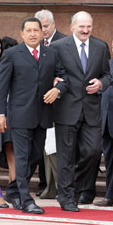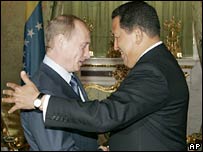The December Crisis
The National Work Stoppage called for December 2nd has grown into the most dangerous crisis the Chávez administration has faced since April. Can the government ride this one out?
Eight months ago, an oil-sector strike escalated into a general work stoppage that brought the Chávez regime to its knees. This time, it's been the other way around, with a general work stoppage escalating into an oil strike, but the results look to be the same. As this issue goes to press, the Chávez administration appears as wobbly as it did in the second week of April, stuck in its rhetoric of unending escalation, and autistically unable to acknowledge the facts that surround it.
But if the similarities are obvious, the differences are even more relevant. In April, Chávez faced a scattershot opposition, a hodgepodge of parties, movements, unions and businessmen with little effective coordination and a multiplicity of ends. Today, the opposition has come together remarkably, congealing in the Coordinadora Democrática. It has had months to learn to work together, to work out its differences through talks, to reach decisions via consensus, and, most importantly, to air out differences in private but preserve a solid unity when dealing with the government. The fractures between moderates and radicals appear ever less relevant, with both sides committed to presenting a common front.
That unity has been aided tremendously by the amazing clumsiness with which the government has handled the crisis. And while that can't be said to be a change from April, what is new is the government's propensity to use violence to reach its goals. On April 11th, the regime's willingness to turn guns on its opponents shocked the nation and the world - it had never happened before. But by now, shooting has become standard procedure for government backers. Government followers have used guns at political events at least seven times since August: starting with the anti-PM ambush on August 12, then during the rioting in front of the Supreme Tribunal two days later, then the ambush at two roads into Caracas hours before the march on October 10th, the march to hand in the signatures to demand a nonbinding referendum on November 4th, then the riots outside the Metropolitan City Hall the following week, and culminating with the appalling massacre at Plaza Altamira on December 6th.
This new propensity to violence goes a long ways towards explaining the opposition's newfound unity. Faced with an aggressive regime, the moderates have been pushed into increasingly hard-line positions. At the same time, radicals have come to understand the need for negotiation in dealing with such a dangerous situation. Overall, the sense of common struggle against a radicalized enemy has generated a remarkable esprit de corps in the coordinadora, and the distance between moderates like Elias Santana and radicals like Andrés Velásquez has never been less.
Saving the paro
In fact, it was the excesive use of force by the government that's saved the fledgling general strike called for Dicember 2nd from what might have been a devastatingly embarrassing failure. On the first day of the strike, the opposition had plenty of reason to worry. While most shops in the East-side of Caracas were shut, vast stretches of the west-side, and the rest of the country, enjoyed an almost normal day. And Tuesday morning was even worse, with more shops opening and more traffic on the roads. What's more, the National Elections Council voted again on the call to a nonbinding referendum for February 2nd, this time by the requisite 4-to-1 margin, a decision that seemed to remove much of the reason for the stoppage. At that point PDVSA's workers were hesitant to give decisive backing to the action, fearing they would lose their careers over a lost cause.
Some organizers worried privately that the entire strike innitiative had been misconceived; that the CNE's decision would cause a fatal rift in the Coordinadora. Though the government had refused to install the OAS-mediated negotiating table formally, informal talks were on their way to swap the end of the strike for an end of the government's takeover of the Metropolitan Police. At noontime Tuesday, sources close to the talks considered it a done deal. But then, around lunch-time, the government stepped in to save the strike.
What happened is that a small band of opposition activists, angry at the seeming failure of the strike, started roaming the Francisco de Miranda avenue in Los Ruices forcing open shops to shut down. Their attitude was certainly aggressive, but not violent. But the government's response was heavy handed by any measure, sending a National Guard unit to repress them using copious amount of tear gas and rubber pellets.
Meanwhile, a small number of people had gathered outside PDVSA Chuao to speak to the press about the pressure some PDVSA managers had been put under, and to reject the arrest of Gualberto Bello, the pro-stoppage head of human resources at the El Palito refinery. Within minutes, National Guard units showed up in large numbers to repress the completely peaceful gathering in a similarly heavy handed way, shocking TV viewers all over the country. What came next, however, would save the fledgling strike.
While tear gas had been useful for dispersing the PDVSA managers in Chuao, it had done nothing to disperse the media crews on the scene, since almost all of them were wearing gas masks. But the guardsmen insisted on clearing the space, swinging batons and shooting rubber pellets indiscriminately, at close range, into the assembled journalists, as their cameras carried the images live to the rest of the nation. In the space of less than an hour, this senseless show of force antagonized and radicalized the two constituencies that are most dangerous to the government: PDVSA's managers, and the news media.
The Nuclear Option
By Wednesday, dissident managers decided to cross the rubicon, shutting down the Oil Industry entirely for the first time in its history. It's the proverbial "nuclear option" in Venezuelan politics.
And it worked. Absenteeism spread throughout PDVSA's facilities quickly. As refineries implemented safe-stop procedures, docks shut down, gas pipeline pressures decreased and storage tanks filled up, the entire production chain ground to a halt. That night, the crew of the oil tanker Pilín León joined the action, quickly becoming the symbollic center of the stoppage. President Chávez, as usual, made things worse by giving a belligerent speech slamming the strikers as criminals and saboteurs and the Pilín Leon's crew as "pirates." The result? By Thursday morning seven other tankers had joined the strike, and by week's end all but two of PDVSA's tankers were anchored and on strike.
Wednesday also saw the spread of antigovernment rallies all over the country, with some becoming quite violent. Several people were hurt in Barquisimeto and San Cristóbal, where pro-Chávez state governors ordered heavy-handed police responses to the protests. Tense confrontations were reported in cities throughout the country. Late night on Wednesday even witnessed the plainly surreal sight of a street riot in Prados del Este, a sleepy, upper class neighborhood in the East side of Caracas, after neighbors launched a pot-banging protest outside the house of General Eugenio Gutiérrez, head of the National Guard.
As dawn broke on Thursday, the media reported that PDVSA's headquarters in La Campińa had been surrounded by a group of perhaps 2000 chavistas, headed by Mayor Freddy Bernal. Bernal quickly denied he had been there, until an amateur video arrived in Globovisión showing the mayor clearly leading a group of heavily armed civilians. The video also showed a face recognized by few and remarked on by none at first: Joao Gouveia's.
The opposition, which had been planning to march from PDVSA's Chuao offices to its La Campińa seat, cancelled the march, calling the chavista gathering an ambush. Instead, attention focused again on the oil industry and the tanker fleet. After four days of dwindling operations, the first fuel shortages were starting to be felt, most strongly in Valencia and Maracay, cities supplied from the Yagua tanker-truck filling station, which had been hard hit. Caracas, which is supplied via a different route, remained well stocked.
Throughout the crisis, the government had refused to return to the OAS brokered negotiating table, demanding that the strike be lifted first. But by Thursday evening, the crisis had become dire enough for the government to offer to return, though the pledge came only at the end of another combative speech, this time from Education Minister Aristóbulo Istúriz. But as Friday wore on, the opposition was kept waiting for a government's delegation that never arrived.
Massacre
Then, at about 7 in the evening, everything changed. Shots were heard at Plaza Altamira. The crowd gathered there dived to the ground in panic, as TV cameras carried the scenes live to millions of anguished households. Once the panic lifted, three people had died and 28 had been injured, several seriously. Within minutes, seven people had been arrested, including one Joao Gouveia, a Portuguese citizen caught on video 48 hours earlier at the chavista rally in La Campińa, just inches from Freddy Bernal. He claimed he had been trying to hit the Globovisión crew on the scene. Additionally, an amateur audio recording was published, apparently between military officers at Fuerte Tiuna who seemed to have advanced knowledge of what would happen.
The shootings galvanized the anger of the opposition, which pointed the finger at the government from the start. Wasting a valuable opportunity to remain quiet, President Chávez went on the air to say that Gouveia's confession was not sufficient proof that he was guilty. Presumably the dozens of eye-witnesses and the physical evidence will also be dismissed as insufficient, even while the government holds that Otto Neustadtl's sole off-the-cuff statement on the April 11th shootings is definitive proof of the opposition's guilt.
The opposition stiffened its demands, riding a wave of intense anger over the shootings, and now asked for the president's resignation and immediate elections, rather than the mere nonbinding referendum they'd called for just hours earlier. But the government stayed away from the negotiating table, now alledging that the furious cacerolazo outside the Meliá was too great a security risk and asking for the talks to be moved to the Military Circle, a request that was plainly unacceptable to the opposition. As this article is written - Saturday afternoon - the Negotiating Table has still not been installed. However, breaking the diplomatic silence over the crisis, the government of Peru did take the initiative to call a special meeting of the OAS Permanent Council to discuss the crisis. The opposition will send a delegation to speak at the meeting.
All through the night from Friday to Saturday, the crew of the Pilín León reported it had been approached by Navy units carrying a judge and a public prosecutor who were seeking to board the ship, but would not allow the crew's lawyers to board. Finally, at noontime Saturday the ship was boarded by an elite Navy unit, the crewmemebers were stripped of their cellphones and left incommunicado, while a replacement crew was brought on board. There are reports of similar operations in an oil tanker off the Puerto La Cruz port. The decision prompted the port crews at La Guaira and Puerto Cabello to join the strike, shutting down much of the country's port infrastructre. The government continues to bluster, but it looks increasingly unable to stem the protests.
Looking ahead
The opposition is clearly on the driver's seat of the Venezuelan crisis, riding a wave of popular revulsion at the violence of December 6th that's not to be underestimated. To its credit, even faced with the incredible provocation of the Plaza Altamira, the opposition has stuck to the course of negotiations, elections, and constitutional change. Even in the heat of the minutes immediately following the massacre, for instance, congressman Julio Borges had the presence of mind to remind the crowd of Gandhi's maxim - "An eye for an eye will leave the whole world blind." Most coordinadora leaders, though incensed by yesterday's violence, are bringing competent and responsible leadership to what is now the overwhelming majority of the Venezuelan people.
Which is not to say that the president's supporters have abandoned him. On Saturday, a pro-government marched filled the streets of downtown Caracas, gathering as many as 100,000 people, though many were bussed in from the provinces. The private media gave almost no coverage to the march, repeating one of the most unfortunate errors of last April. It is worth noting that even in this most embattled juncture, a significant number of people still support Chávez vehemently, and are still willing to march for him. As it approaches what looks for all the world like a final confrontation with his regime, the opposition must keep that in mind to refrain from the kind of catastrophic miscalculations of April 12th.
|

 Chavez Reelection Blog: Katy documents the government's use of public resources for Chavez's partisan advantage.
Chavez Reelection Blog: Katy documents the government's use of public resources for Chavez's partisan advantage.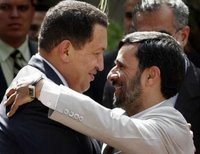
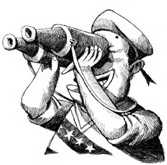
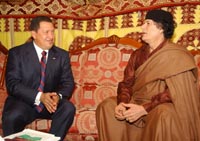
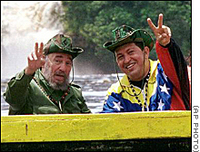
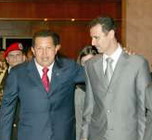
 Site feed
Site feed 